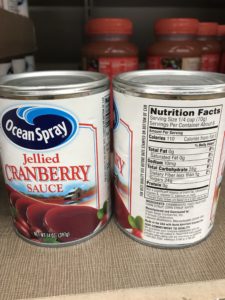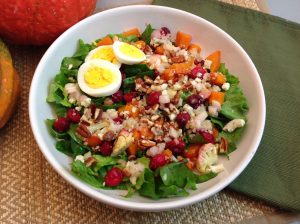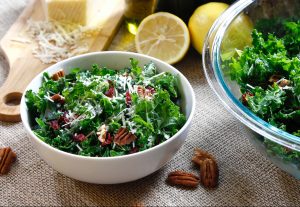 As November rolls around, we can’t help but start thinking about the holidays.
As November rolls around, we can’t help but start thinking about the holidays.
And, there is a fruit that seems to go hand-in-hand with the holidays (believe it or not, 20% of annual consumption takes place during Thanksgiving week), but we really should be enjoying it all year long!
It’s cranberries…
and it’s our November Superfood of the Month!
What are cranberries?
 Cranberries grow on low creeping shrubs or vines, which produce fruit year after year. They are initially light green, and then turn red when ripe. This edible fruit has an acidic and tart taste, which usually overwhelms its sweetness.
Cranberries grow on low creeping shrubs or vines, which produce fruit year after year. They are initially light green, and then turn red when ripe. This edible fruit has an acidic and tart taste, which usually overwhelms its sweetness.
Cranberries are one of the few fruits native to North America and have been used in cooking for hundreds of years – legend has it that, in 1663, a Pilgrim cookbook even included a recipe for cranberry sauce!
Today, approximately 98% of the world’s production comes from the United States, Canada and Chile, with Wisconsin making up most of the U.S. production. It is reported that only 5% of the cranberries are sold fresh, and the rest are turned into juices, sauces and other products.
A pool of cranberries?
There are two ways to harvest cranberries: dry harvest and wet harvest.
Dry harvesting uses walk behind machines to remove the berries from the vines, which is the method used to supply the fresh cranberry market.
Have you seen Ocean Spray commercials where the men are standing in a lake of cranberries? This shows the fascinating method of wet harvesting which is done for cranberries that will be processed and/or used for dried cranberries.
Because cranberries have pockets of air inside, they float in water. The bogs (or fields) of cranberries are flooded with 6-8 inches of water, and then machines (referred to as egg beaters) stir up the water and remove the fruit from the vines where they float to the surface. The cranberries are then gathered and pumped out or lifted out with a conveyor.
If you want to impress your kids, show them how good, ripe cranberries will bounce, which is why you may hear them referred to as bounceberries. Cranberries are at their best October through December, which makes them perfect for the holidays.
Why cranberries?
Low in calories, fresh and frozen cranberries are loaded with many star nutrients such as vitamins A, C and K, and provide several powerful health benefits:
- They contain highly-beneficial antioxidants and anti-inflammatory properties.
- They help prevent urinary tract infections, enhance our immune systems and provide cardiovascular benefits.
- They lower our bad cholesterol (LDL) and increase our good cholesterol (HDL).
- They contain powerful cancer fighters, especially when it comes to reducing the risk of breast, colon, lung and prostate cancers.
How do you select fresh cranberries?
When buying fresh, they should be plump and firm, with a deep red color (firmness is the primary indicator of quality). They can be refrigerated for 2-3 weeks or kept frozen for months.
Most of their beneficial nutrients come from the flesh and the skins of the cranberries. This is where you must be careful not to assume everything containing cranberries is good for you. For example, cranberry juice is often made by processing the berries (leaving the flesh and skins behind), and then adding generous amounts of sugar. Believe it or not, some cranberry juices can have even more sugar that regular soda.
What about dried cranberries?
 Because cranberries are naturally very tart, sugar is added to make them sweeter. Dried cranberries, sometimes referred to as “Craisins” (which is a word developed from the Ocean Spray trademark), are no exception. Dried cranberries generally contain the same nutrients as fresh (mostly dietary fiber and antioxidants), but the commercial drying process does reduce their Vitamin A and Vitamin C content. The overall nutrient profile is also reduced when sugar is added.
Because cranberries are naturally very tart, sugar is added to make them sweeter. Dried cranberries, sometimes referred to as “Craisins” (which is a word developed from the Ocean Spray trademark), are no exception. Dried cranberries generally contain the same nutrients as fresh (mostly dietary fiber and antioxidants), but the commercial drying process does reduce their Vitamin A and Vitamin C content. The overall nutrient profile is also reduced when sugar is added.
In addition to the sugar that is often added to reduce tartness, oil is sometimes added to prevent them from sticking together. It is possible to find dried cranberries that are oil-free and sweetened with apple juice (instead of sugar) or, if desired, no sugar at all…you need to read those ingredient labels!
What can you do with fresh cranberries?
 Cranberries do taste best when lightly sweetened, and it can be done with REAL ingredients!
Cranberries do taste best when lightly sweetened, and it can be done with REAL ingredients!
- Offset the tartness by adding other fruits like apples, oranges or pineapple
- Add a little honey or pure maple syrup (this is how our ancestors enjoyed cranberries)
You can get the nutrition benefits of fresh cranberries, with just the right amount of sweetness, in a variety of delicious ways!
Here are a few of our favorite ideas using fresh cranberries:
- Roasted Autumn Salad
- Cranberry Apricot Chutney – ideal for grilled chicken or the Turkey Cranberry and Brie Grilled Cheese!
- Christmas Burger
 Cranberry Pomegranate Relish – no cooking required — served cold, and is so good you can eat it with a spoon!
Cranberry Pomegranate Relish – no cooking required — served cold, and is so good you can eat it with a spoon!- Orange Ginger Cranberry Sauce – the perfect warm accompaniment to serve with your juicy Thanksgiving turkey. Plus, ideal topping for leftover turkey sandwiches!
- Baked Oatmeal Cups – add cranberries to the variety of mixed fruit in these amazing oatmeal cups.
How do you enjoy dried cranberries?
Dried cranberries can also be added to so many incredibly great-tasting meals and snacks. Just a few fantastic examples include:
 Massaged Kale Salad
Massaged Kale Salad- Almond Butter Bites
- Cranberry Coconut Granola
- Cranberry and Pecan Couscous
- Cranberry Feta and Walnut Salad
- Shredded Brussels Sprouts with Pistachios, Cranberries and Parmesan
- Wild Rice Stuffed Acorn Squash
- Squash and Chicken Tagine
- Sweet Potatoes with Pecans and Goat Cheese
- Cranberry Orange Muffins
Of course, we couldn’t do a coaching tip on cranberries without addressing cranberry sauce….
 what about that red, wobbly dish that sticks out like a sore thumb on your Thanksgiving Day table?
what about that red, wobbly dish that sticks out like a sore thumb on your Thanksgiving Day table?
You know what we are talking about…the one that keeps its jiggly form, and even includes the ridges from the can! In our family, it’s always there, but we have asked, and no one knows exactly why it has become a staple at our Thanksgiving dinner.
Have you looked at the canned cranberry sauce ingredient label? We hate to burst your bubble, but it’s not good! Check out our coaching tip for much better for you — and much better tasting — options to the canned cranberry sauce! We want to help you keep REAL food at the center of your Thanksgiving feast!
We encourage you to try cranberries in different ways — and introduce new ways to enjoy them in your upcoming holiday meals!
Please share your ideas!
Do you have a favorite way to enjoy cranberries?




My one year old grandson loves pomegranate! Not me..
We love them too, but they used to intimidate us – we had no idea how to get the seeds out! Feel free to check out our coaching tip on pomegranates to learn more! Thanks again for the feedback!
I always make fresh cranberry sauce but just like the can, no one ever eats it, maybe I will just stick to dried in my salad this year and forego the sauce no one ever eats. The Cranberry Pomegranate looks good—-waiting for my new food processor to arrive.
Isn’t that funny that the cranberry sauce doesn’t disappear like other parts of our holiday meal? Please let us know if you make the Cranberry Pomegranate — it really is delicious! Enjoy the new food processor!